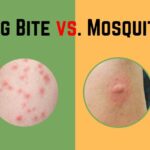
Ticks are infamous for their bites; they are tiny arachnids that can be found in our backyards, long grasses, and forested places. To potentially prevent tick-borne infections and to intervene early, it is imperative to recognize the initial look of a tick bite. Let’s examine, what does a tick bite look like at the early phases and recognize the warning signals that need to be taken seriously.
What does a first tick bite look like?

A tick bite usually leaves a small, raised bump on the skin as evidence of its origin. Because of its small size in these early stages, the bite might easily go undetected. For people who may be exposed to places where ticks are present, the subtlety of the initial appearance highlights the difficulty of prompt detection and the significance of careful observation.
Redness and Irritation
An obvious alteration happens a few hours or days after the initial tick bite when a reddish patch starts to grow around the bite site. Although it frequently takes the shape of a circle, this redness can also assume other irregular forms.
Concurrently, the area of skin around the bite becomes inflamed, potentially leading to itching. This development indicates the body’s sensitivity to the invasion and sets off inflammatory processes that help produce the apparent alterations in the affected area.
Localized Warm and Moist Areas
Ticks have a clear inclination toward warm, wet spots on humans. Consequently, bite sites are often located in areas like the groin, armpits, or inside hair.
The ticks’ adaptive strategy of seeking out conditions that support their feeding habits is reflected in their localization within particular bodily parts. Knowing these hotspots improves people’s awareness when they’re in areas where ticks could be common, which helps with early detection and prevention.
What does a tick bite look like in a week?

Continued Redness and Expansion
The effects of a tick bite intensify over the week. The bite site’s surrounding redness may linger and perhaps get bigger. This progression highlights how the body’s reaction to the tick’s invasion has changed over time, indicating a continuous inflammatory response.
People are urged to keep a close eye on the development to spot any notable patterns or changes, as the persistent redness turns into a visual indicator.
Potential Bullseye Pattern
The increase in redness may exhibit a particular pattern, most notably looking like a bullseye, especially if the tick that caused it is Lyme disease-positive.
A core red spot or bite that is encircled by a clear area and an outside red ring is what distinguishes the bullseye design. Even while not all tick bites follow this pattern, its existence is a serious indicator that needs to be taken seriously and raises questions about the possibility of Lyme disease transmission.
Itching and Possible Central Dot
The area around the bite site may start to itch more at this phase, therefore it’s important to avoid scratching to avoid getting sick. A strange detail may also show up: in the middle of the red area may appear a tiny black dot that represents the tick’s mouthparts.
This discovery highlights the importance of carefully inspecting the afflicted area and gives a more nuanced perspective to the visual cues connected to a tick bite.
What does a tick bite look like after a week?
The remaining redness and swelling around the tick bite may still be there even after a week, especially if treatment is not received. Rarely, there may be several red spots at the bite site, which could be an indication of the spread of diseases carried by ticks.
This enduring redness emphasizes the value of ongoing monitoring, and any enduring symptoms should be carefully evaluated and may require medical intervention.
You may also like:
FAQs
What is the initial appearance of a tick bite?
How does the appearance of a tick bite change over time?
Why are tick bites often found in warm and moist areas?
What does a tick bite look like after a week?
What is the significance of a bullseye pattern in tick bites?
Why is itching a notable symptom in tick bites?
What lingering effects might be present after a week of a tick bite?
When is seeking medical attention necessary after a tick bite?
Conclusion
Seeking medical assistance becomes necessary if the redness doesn’t go away, spreads dramatically, or manifests accompanying symptoms like fever, exhaustion, or joint discomfort. Seeing a physician as soon as possible guarantees a thorough assessment of the circumstances and rapid advice on possible treatments.
The fact that symptoms change after a week emphasizes how dynamic tick bites can be, emphasizing the importance of close observation and early intervention in the medical field.


